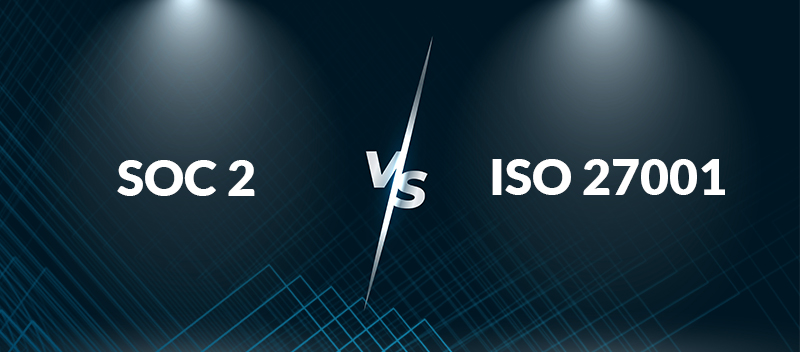SOC 2 vs. ISO 27001: Key Differences

Understanding SOC 2 and ISO 27001 Certifications
Dive into the world of information security certifications where SOC 2 and ISO 27001 stand as prominent benchmarks, each offering a framework for safeguarding data tailored to different operational landscapes.
Unpack their unique processes and timelines, clarifying how they establish trust in your company’s commitment to protecting client information.
Scope and Market Applicability
SOC 2 targets service providers specifically, focusing on trustworthiness in handling customer data. In contrast, ISO 27001 applies broadly to organizations looking to establish robust information security systems.
These frameworks are not one-size-fits-all; companies must weigh their unique compliance needs and determine which standard aligns with their operational scope.
Globally recognized, ISO 27001 has wide-reaching market applicability across various industries for its comprehensive approach to securing sensitive information. SOC 2 typically resonates more with U.S.-based businesses, especially those involved in technology and cloud computing services, where demonstrating rigorous standards is crucial for client engagement.
Businesses use these strategic standards as baselines to measure and enhance system security controls. The next step involves understanding the detailed certification process and project timeline that each framework requires.
For more on our SOC 2 and ISO 27001 compliance services Click Here
Certification Process and Project Timeline
SOC 2 and ISO 27001 certification processes are rigorous but structured to ensure companies meet high data protection standards. Both require preparation, documentation and a series of assessments by external auditors.
- Start with an internal security assessment: Companies begin by evaluating their existing information security practices against compliance requirements.
- Assemble a dedicated project team: This group oversees the certification process, ensuring all steps are completed correctly and on schedule.
- Implement necessary improvements: Based on the initial assessment, companies change their security controls to meet specific standards.
- Develop comprehensive documentation: Organizations must document their policies, procedures, and controls as evidence of compliance.
- Undergo a pre-audit (optional): Some choose to have a preliminary review by an auditor to identify any potential issues before the formal audit.
- Complete the official audit process: An independent auditor assesses the company’s security measures against the compliance framework.
- Address any findings: If auditors note deficiencies, these must be corrected before certification can be granted.
- Achieve certification or examination report: Successful completion results in either an ISO 27001 certificate or a SOC 2 report, demonstrating compliance.
Differences Between SOC 2 and ISO 27001
While both standards serve as the bedrock for robust security regimes, SOC 2 zeroes in on American service providers’ controls relating to client data. In contrast, ISO 27001 offers a global blueprint for an information security management system.
This distinction is pivotal as organizations navigate the certification landscape and align with regulations that cater to their operational and geographical contexts.
Focus on Data Security vs. Service Provider Controls
• SOC 2 closely examines how service organizations manage data, probing deeply into the effectiveness of their security controls. It goes beyond just checking if they have procedures in place; SOC 2 requires proof that these procedures actively maintain the confidentiality and integrity of stored information.
Auditors check for solid practices around availability, processing integrity, and privacy to ensure customer data is handled with the utmost care.
• ISO 27001, on the other hand, casts a wider net on information security management. This standard urges companies to establish an overarching management system covering all data protection and risk management aspects.
It demands a thorough assessment of potential threats to information security and insists on rigorous security measures that address those risks company-wide. The goal here isn’t just securing client data but enveloping all critical business info under one robust shield of protection.
Certification vs. Examination
• While focusing on different aspects of data security and controls, it’s also essential to distinguish between certification and examination processes. Achieving ISO 27001 status means your organization has been certified by an accredited registrar after meeting stringent information security standards.
This accreditation serves as internationally recognized proof that a company aligns with the highest levels of data protection and risk management practices.
• On the other hand, examination is at the heart of SOC 2 compliance. A licensed CPA must conduct a thorough audit to ensure service providers adequately safeguard client data according to the Trust Services Criteria.
Although this process does not culminate in an official certification, successfully passing a SOC 2 audit demonstrates adherence to industry-specific security standards and regulatory requirements, fostering client trust.
The distinction between these two approaches emphasizes different goals: while one results in formal recognition through certification, the other offers examined assurance about specific control environments within an organization.
Both play crucial roles in demonstrating a commitment to comprehensive information security measures.
Similarities Between SOC 2 and ISO 27001
While SOC 2 and ISO 27001 certifications take different approaches to information security, they share a common goal of safeguarding data through robust security practices. Both frameworks encourage organizations to build an effective Information Security Management System (ISMS) that aligns with comprehensive controls and establishes a culture of continuous compliance.
Based on Data Security Best Practices
SOC 2 and ISO 27001 certifications are based on robust data security best practices. They ensure companies manage their sensitive information responsibly by implementing stringent controls and management systems.
These certifications provide a framework that helps businesses protect customer data from unauthorized access, disclosure, or theft. Companies adopt comprehensive policies and procedures to maintain high-security standards across all operations.
Adhering to these best practices signifies an organization’s commitment to securing its data landscape. Service providers seeking SOC 2 certification must demonstrate adequate safeguards for securely handling client information.
On the other hand, ISO 27001 requires an organization to establish a systematic approach within a solid Information Security Management System (ISMS). Both paths lead to enhanced trust with clients and partners, assuring them that their information is managed with due diligence and care.
Overlapping Controls and Requirements
Stepping from the foundation of data security best practices, it’s clear that SOC 2 and ISO 27001 share a substantial common ground. Nearly four-fifths of their criteria align, reflecting their similar data protection and risk management take.
This harmony extends to physical and environmental security, human resources security, access control measures, and information technology communications. Companies striving for compliance often find they are tackling a set of standards that echo each other, making dual certification more streamlined than expected.
Navigating these frameworks reveals that both certifications endorse rigorous audit processes to ensure organizations manage their information responsibly. Much like pieces fitting together in a puzzle, the overlapping controls function seamlessly across both systems.
They underscore the commitment to maintaining robust information security policies—a critical factor for businesses handling sensitive data in today’s digital landscape.
Ensuring continuity in operations while adhering to top-notch security measures stands at the heart of what makes SOC 2 and ISO 27001 indispensable allies in building trust with stakeholders.

Choosing Between SOC 2 and ISO 27001 Certifications
When it’s time to bolster your organization’s credibility with a solid information security certificate, the decision between SOC 2 and ISO 27001 can be pivotal; understanding your company’s specific needs and customer expectations will guide you to the right choice.
Whether seeking to meet market demands or looking for comprehensive risk management, knowing which certification aligns with your goals is crucial for compliance and demonstrating a commitment to robust data protection.
Factors to Consider
Deciding on the proper security certification for your organization involves weighing various factors. These considerations will help guide you toward the most suitable choice between SOC 2 and ISO 27001 certifications.
- Assess your industry’s specific needs since some sectors might favor or require one certification over another due to regulatory compliance demands.
- Determine the geographic scope of your operations, as ISO 27001 is recognized worldwide and might be more suitable for companies with global reach.
- Evaluate whether your company primarily provides services, as SOC 2 specifically targets service organizations and their data management practices.
- Consider your customers’ expectations, as they might have a preference based on their risk management strategies or prior knowledge of either standard.
- Analyze the existing control framework within your organization to identify which controls correspond more closely with your current practices.
- Explore if obtaining both certifications could be beneficial by recognizing that each complements different aspects of information security standards and may enhance trust from various stakeholders.
- Review each certification’s audit and assessment processes; understand that a licensed CPA must complete SOC 2 audits while an accredited registrar must issue ISO 27001 certification.
- Look into the certification process and project timelines to see which aligns better with your organization’s schedules and resource availability, considering both involve a third-party assessment.
- Balance cost implications against potential benefits, considering not just direct expenses but also human resources needed for implementation and maintenance.
Can They Be Obtained Simultaneously?
After weighing the factors, it’s clear that businesses don’t have to choose one certification over the other. Companies can indeed aim for both SOC 2 and ISO 27001 certifications simultaneously.
This dual approach allows organizations to meet regulatory requirements and client expectations regarding information security and data protection.
Working toward both certifications can streamline some processes because they share common elements in risk management and control measures. Firms efficiently leverage overlapping controls to satisfy both criteria, making this combined strategy an intelligent move for those looking to demonstrate comprehensive commitment to information technology security.
Benefits of Both Certifications
Having SOC 2 and ISO 27001 certifications showcases a company’s commitment to robust information security. These credentials act as powerful trust signals, assuring clients that their data is protected under stringent security controls.
They provide an edge in the marketplace, often becoming a differentiator among competitors vying for business where customers prioritize high data protection standards.
With these certifications, organizations demonstrate compliance with international standards and best practices for IT security and risk management. They also benefit from improved internal processes that typically follow the rigorous audit required for certification.
The structured approach necessary to achieve SOC 2 and ISO 27001 tightens security and can lead to greater operational efficiency within the service provider’s environment.
Conclusion
In closing, knowing the distinctions between SOC 2 and ISO 27001 empowers companies to align their security strategies effectively. By distinguishing these frameworks, they can better safeguard customer data and manage internal risks.
Whether opting for one or integrating both, these standards form a strong foundation for robust information security protocols. This selection reflects an organization’s commitment to data protection and compliance excellence.
It sets a clear course for future-proofing a business against evolving cyber threats.
Talk to an expert today.




